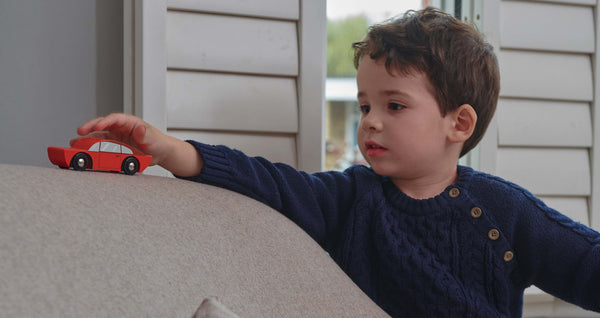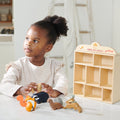Symbolic play | The key to reading

The advent of symbolic play marks a step-change in your child’s thinking.
As a baby, if she picked up a wooden car, she would investigate its properties. What does it feel like? How does it smell? How does it taste? What happens if I bash it, or drop it or roll it?
At some point during her second year, she would understand that the car represented a real car. The object stood in for the real thing. This car is Mummy’s car. It is going to the shops.
Later yet, she could take a wooden block or a stick or a tomato and imagine that that was a car, even though there was no physical resemblance.
And lastly, she learnt that she could become the car. Vroom! Vroom! Watch out! Here I come!
Why is any of this important?
It means your child has learnt to play with ideas rather than objects.
Not only can one object stand in for another but so too can a mark on a page.
This squiggle is a car. This circle is me.
Even better, marks on a page can stand for ideas.
These squiggles mean friend: f-r-i-e-n-d.
We have arrived at reading and writing. Unlike Chinese pictograms or Egyptian hieroglyphs, words and letters in English are abstract - they look nothing like the thing they represent in the real world. It’s a big leap, conceptually, for a child.
But it comes naturally after years of symbolic play.
Toys for symbolic play
So what are the best toys for this kind of play?
There is no right answer. Once your child has grasped the concept, she will happily play with cotton reels and boxes, sock puppets and bottles.

But there’s a mid-point - when symbolic play is just getting established - when the symbols have to look like the thing they represent. Wooden animals stand in for real ones; rag dolls for real people.

Here are a few to try:
- Play kitchen
- Doll’s house
- Train sets
- Cars, roads and transporters
- Wooden animals
At first, the toys must look like the thing they represent. I hold a toy lion and pretend it is the real thing.

But, soon enough, the symbol could be anything. This block is a cat; that car is a telephone.
I am a car. I am the symbol.
Final word
What does this mean for my child's play?
You have to make room for her imagination.
She needs time to explore thoughts and ideas. But she also needs exposure to symbols in the real world. Read stories, look for street signs and logos when you go for a walk, write her name on her bedroom door.
As we saw in the recent post on heuristic play, so much of early learning is about offering an interesting environment with easy-to-access materials.
It’s not complicated; symbolic play comes naturally. But you can help it along if you take a step back and let your child get on with it.





